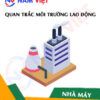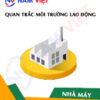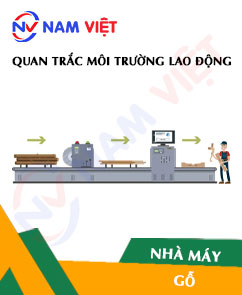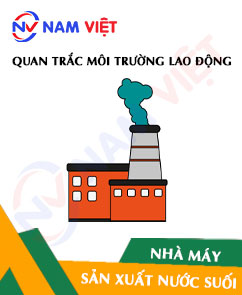Occupational environment monitoring at the factory producing razor blades
99,000 ₫
Note: The above price is calculated for one sample, the price may fluctuate depending on the area of the environment to be monitored and the movement of the market. For more accurate price support, please refer to the quotation table or contact directly with our consulting staff.
Environmental monitoring of razor blade manufacturing factories is a session of collecting, analyzing, and evaluating factors in the workplace that may be harmful to the health of workers.
Table of Contents
Toggle1. Overview of Razor Blade Manufacturing Factories
a. What is a razor blade manufacturing factory?
A factory for razor blade manufacturing, also called a razor blade production factory, is a facility specialized in producing and manufacturing razor blades. Razor blades are essential components of shaving tools, used for shaving facial hair and removing hair from the skin surface.

b. Production stages in a razor blade manufacturing factory
The production process in a factory may include the following stages:
- Material preparation: Preparing necessary materials such as carbon steel or stainless steel for razor blade manufacturing.
- Processing and shaping: Using specialized machinery to cut, grind, and shape razor blades according to design and required dimensions.
- Sharpening: Using advanced grinding technologies to sharpen razor blades to achieve high sharpness.
- Plating and protection: Applying protective coatings on the razor blade surface to prevent rust and extend product lifespan.
- Quality control: Inspecting each razor blade to ensure it meets standards for sharpness, durability, and safety.
- Packing and boxing: Packaging razor blades into suitable containers and boxing them for transportation and distribution.

c. Machinery used in razor blade manufacturing factories
Razor blade manufacturing factories use several key types of machinery, including:
- Steel cutting machines: Used to cut and shape razor blades from steel sheets.
- Grinding machines: Used to grind and sharpen razor blades to precise shapes.
- Specialized processing machines: Include machines for specific stages such as heat treatment, chemical processing, surface treatment, etc.
- Plating and electroplating machines: Used to apply protective coatings like chrome or other layers on the blade surface.
- Quality inspection machines: Equipment for testing sharpness, hardness, durability, and other properties of razor blades.
- Packing machines: Used to package razor blades into boxes, plastic or paper packaging.
- Boxing and transportation machines: Used to pack razor blades into larger cartons ready for shipping and distribution.

d. Occupational diseases for workers in razor blade manufacturing factories
Workers in razor blade manufacturing factories may face several occupational diseases related to workplace factors and production processes. Common occupational diseases include:
- Respiratory diseases: Exposure to metal dust, iron dust, and other irritants may cause lung diseases, including pneumonia, bronchitis, and metal dust pneumoconiosis.
- Nervous system diseases: Using electrical devices and machinery can generate noise and vibration, affecting the nervous system.
- Skin diseases: Contact with chemicals during production may cause skin irritation, dermatitis, and allergic reactions.
- Musculoskeletal disorders: Tasks requiring physical effort or improper posture can lead to joint degeneration, arthritis, and injuries.
- Eye strain: Working in low or overly bright lighting may cause eye fatigue and impair vision health.
To reduce the risk of occupational diseases, safety measures must be implemented, including using personal protective equipment, ensuring proper ventilation, minimizing exposure to harmful substances, and complying with occupational safety regulations. Workers should follow safe work procedures and undergo regular health checks to detect and treat work-related health issues early.

e. Common types of razor blades on the market
Common types of razor blades include:
- Straight razor: A straight-blade razor used for shaving or grooming.
- Cartridge razor: A handheld razor with replaceable blade cartridges, commonly used for everyday shaving.
- Multi-blade razor: Razors with multiple parallel blades on a single handle, increasing shaving efficiency.
- Electric razor: Electric-powered razors with rotating or vibrating blades for automated shaving.
- Precision razor: Specially designed razors for precise cutting, often used in artistry, craftsmanship, or medical applications.
2. Overview of Occupational Environmental Monitoring Services
a. What is occupational environmental monitoring at a razor blade factory?
Occupational environmental monitoring (or workplace environmental measurement) at a razor blade manufacturing factory involves collecting, evaluating, and analyzing workplace environmental factors to implement timely interventions, minimize health hazards, and prevent occupational diseases. Environmental monitoring is mandatory for razor blade factories.
Occupational environmental monitoring is crucial for protecting and enhancing worker health, as employees are the main workforce and directly generate profit. Frequent exposure to harmful factors beyond permissible limits can adversely affect health and cause occupational diseases.
REGISTER FOR OCCUPATIONAL ENVIRONMENTAL MONITORING SERVICE
b. Nam Viet’s occupational environmental monitoring program
Nam Viet’s occupational environmental monitoring program is developed by engineers in the fields of occupational safety and environmental protection. It uses modern measurement methods to monitor air quality, water quality, microclimate, physical factors, dust, and more in the workplace. This program is critical to ensuring a safe working environment and protecting worker health.
Additionally, Nam Viet’s program helps research and develop new solutions to improve workplace environmental quality. With the dedication and professionalism of its monitoring team, Nam Viet’s exclusive program is a breakthrough in occupational safety and environmental management in Vietnam.

c. Standardization in occupational environmental measurement procedures
Standardization ensures measurement accuracy and reliability. Nam Viet’s program follows recognized standards and procedures from the Ho Chi Minh City Department of Health. Measurements are conducted by highly qualified monitoring specialists, ensuring reliable results for workplace evaluation and management decisions.
By applying standardized procedures, Nam Viet demonstrates its commitment to a safe working environment and contributes to advancing occupational safety and environmental quality in Vietnam.
d. Reporting monitoring results for razor blade factories
Monitoring results are prepared according to Form 04, Appendix III issued with Decree 44/2016/ND-CP and produced in two copies: one sent to the workplace that contracted the service and one retained by the monitoring organization. Results are stored indefinitely according to legal regulations.

e. Frequency of occupational environmental monitoring according to law
According to Clause 2 of Article 18, Law on Occupational Safety and Health 84/2015/QH13, employers must conduct occupational environmental monitoring at least once per year.
f. Deadline for submitting monitoring reports according to law
The deadline is before December 31 each year. Businesses must submit monitoring reports to the Department of Health at the location of their headquarters and where employees work. Updates are required if technology, production processes, or workplace renovations introduce new harmful factors.
g. Penalties for violations of occupational environmental monitoring regulations for employers
According to Article 27 of Decree 12/2022/ND-CP, administrative fines apply:
- Clause 2: 2,000,000–5,000,000 VND for not publicly disclosing monitoring results to workers immediately.
- Clause 3: 20,000,000–40,000,000 VND for failing to conduct occupational environmental monitoring.
- Clause 4: 40,000,000–60,000,000 VND for colluding with monitoring organizations to commit fraud in monitoring activities, without reaching criminal liability.
3. Harmful environmental factors for workers in razor blade manufacturing factories
In razor blade manufacturing factories, there are several environmental factors that may harm workers. These factors include:
- Chemicals: During razor blade production, chemicals such as oils, cleaning solutions, detergents, and other chemical compounds may be used. Exposure to these substances in an industrial environment can cause skin irritation, dermatitis, respiratory problems, and other health issues.
- Dust and fine particles: The processing and grinding of razor blades can generate dust and fine particles in the air. Inhaling these fine particles can irritate the respiratory system, cause pneumonia, and damage workers’ respiratory health.
- Noise: Machinery in razor blade factories often generates high noise levels. Continuous and loud noise can harm hearing and cause stress for workers.
- Temperature and humidity: Certain production processes may create high-temperature or high-humidity working environments. Prolonged exposure to high temperatures can lead to fatigue, pain, and damage to skin and body. High humidity can promote the growth of bacteria and mold, causing skin irritation and respiratory problems.
- Mechanical impacts: During processing and production, workers may come into contact with cutting, grinding, or pressing equipment and tools. Failure to follow safety rules when working with these machines can result in accidents, injuries, and damage to muscles, bones, and skin.
REGISTER FOR OCCUPATIONAL ENVIRONMENT MONITORING SERVICE
4. Measures to improve the working environment in razor blade manufacturing factories
To improve the working environment in razor blade manufacturing factories and protect workers’ health, the following measures can be applied:
- Ventilation and dust extraction systems: Install efficient ventilation to ensure air circulation in the factory and remove dust and fine particles from processing. Dust extraction systems should be installed at workstations to collect and remove dust effectively.
- Ensure safety procedures: Ensure that workers are trained on safe work procedures and use appropriate personal protective equipment (PPE), including masks, goggles, gloves, and ear protection as needed.
- Noise control: Implement noise control measures such as ear protection devices, noise-canceling masks, or soundproof barriers to reduce noise to safe levels for workers.
- Comfortable temperature and humidity: Maintain temperature and humidity conditions at comfortable levels for workers. Use air conditioning or ventilation systems to regulate temperature and humidity appropriately.
- Mechanical safety: Ensure workers are trained to use tools and equipment correctly, comply with occupational safety rules, and wear protective equipment such as gloves, protective clothing, and goggles when working with cutting, grinding, and pressing machinery.
- Regular inspection and maintenance: Conduct periodic inspections and maintenance of equipment, machinery, and systems to ensure stable operation and reduce the risk of accidents due to malfunctions.
- Training and education: Provide training on occupational safety, health, and environmental awareness, including identifying and responding to potential hazards, using safety equipment, and following proper work procedures.
- Promote safety and environmental awareness: Create a workplace culture that enhances safety awareness, encourages reporting of hazards, and suggests measures to improve the working environment.
- Periodically conduct occupational environment monitoring in factories, collecting and analyzing harmful factors affecting workers, and adjusting to reduce risks to prevent occupational diseases.
5. Benefits of periodic monitoring in razor blade manufacturing factories
An Toan Nam Viet provides businesses with outstanding benefits when using occupational environment monitoring services according to Decree 44/2016/ND-CP on the management and control of harmful workplace factors affecting workers.
- Businesses can proactively control harmful factors in workshops or factories.
- Receive recommendations on measures to reduce harmful factors and improve workplace quality.
- Indirectly protect human resources, a key factor in business development.
- Reduce the harmful impact of occupational diseases on human health, lowering future treatment costs.
- Enhance worker health, ensuring product quality and maintaining production output.
- Comply with labor safety laws and avoid legal risks.
- Enhance credibility and professionalism in all aspects, elevating the company brand.
Nam Viet’s environmental monitoring service is a solution to reduce occupational disease risks, contributing to a clean and high-quality working environment.

6. National occupational environment monitoring center
Occupational environment monitoring center of Nam Viet is a professional unit in supervising and measuring occupational environment quality throughout all provinces in Vietnam. With a team of experienced monitoring specialists, the center uses modern measurement equipment to ensure accuracy and reliability.
In addition to monitoring services, the center assists clients in planning, handling, and tracking workplace environmental issues. With the motto “customer-centered,” the center prioritizes customer satisfaction, meets all client needs, and commits to providing the best solutions for businesses.
REGISTER FOR OCCUPATIONAL ENVIRONMENT MONITORING SERVICE
With investment in technology, equipment, and human resources, Nam Viet’s monitoring center has become one of the most reputable units in occupational environment monitoring in Ho Chi Minh City, with the following objectives:
- We always value our brand reputation and service quality.
- We provide customers with the best and most suitable solutions possible.
- Alongside a team of experienced Masters and Engineers, committed to environmental protection and business benefit.
- At Nam Viet Environmental Monitoring, companies receive professional service from field experts and the best cost advantages.
The occupational environment monitoring process at Nam Viet includes the following basic steps:
- Before conducting monitoring, our company ensures all equipment is calibrated according to legal regulations.
- Follow the occupational environment monitoring procedures committed to the Department of Health accurately and fully.
- Report monitoring results honestly to employers.
- If monitoring results indicate unsafe conditions, Nam Viet provides corrective solutions, and the workplace implements the following:
- Implement measures to improve working conditions, minimize harmful factor impacts, and prevent occupational diseases.
- Conduct health examinations to detect occupational and related diseases early for workers in unsafe environments.
- Provide in-kind compensation to workers according to labor law.

7. Occupational environment monitoring quotation
To help businesses conduct professional and effective occupational environment monitoring, Nam Viet provides clients with a quotation for occupational environment monitoring services with quality and reasonable costs.
- Our quotation provides detailed pricing information for the monitoring services we offer, including costs related to travel, measurement, analysis, and reporting. Clients can trust the accuracy and reliability of the monitoring reports we provide.
- We commit to offering competitive and reasonable prices in the market and are always ready to provide quick and professional advice for any inquiries regarding monitoring services.
- With Nam Viet’s monitoring quotation, clients can easily select service packages suitable to their needs. We are committed to delivering the highest satisfaction with professional service quality.
No comments yet












Review Occupational environment monitoring at the factory producing razor blades
There are no reviews yet.